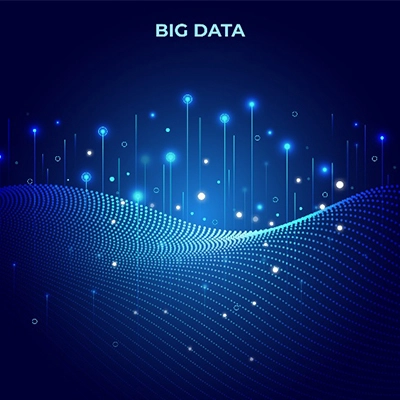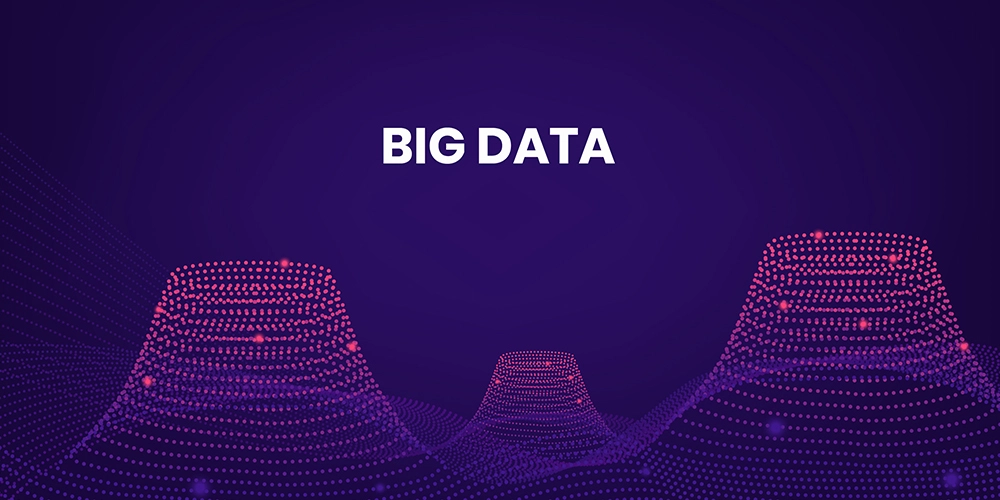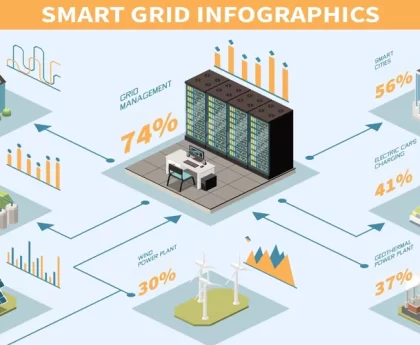Big Data: Refers to the vast and intricate collection of data that is too large and complex to be processed and analyzed using traditional data management tools and techniques. This data is characterized by its three main dimensions, often referred to as the three V’s:
- Volume: Big data involves massive amounts of information generated from various sources, including sensors, social media platforms, online transactions, and more. The volume of data is so substantial that it exceeds the capabilities of conventional databases and processing systems.
- Velocity: The speed at which data is generated, collected, and shared defines the velocity of big data. With the advent of real-time data sources such as IoT devices and social media interactions, information is produced and transmitted at an unprecedented pace, requiring efficient processing methods.
- Variety: Big data encompasses diverse types of data, including structured, semi-structured, and unstructured data. This data can include text, images, videos, sensor readings, and more. Managing and analyzing such a wide range of data formats presents challenges that traditional databases aren’t well-equipped to handle.
Types of Big Data
Big data can be categorized into different types based on various characteristics and sources.
The main types of big data are often classified using the following dimensions:
- Structured Data: This type of data is organized and follows a well-defined format, typically stored in relational databases. It includes data with clear rows and columns, making it easy to query and analyze. Examples include data from spreadsheets and traditional databases.
- Unstructured Data: Unstructured data lacks a specific format and organization. It includes text-heavy content such as emails, social media posts, videos, images, and audio files. Analyzing unstructured data requires specialized tools like natural language processing (NLP) and machine learning.
- Semi-Structured Data: This type of data falls between structured and unstructured data. It has some organization and may have tags, labels, or hierarchies, but it doesn’t conform to a rigid structure like traditional databases. Examples include JSON and XML files.
- Text Data: Text data refers to any form of written content, including articles, documents, tweets, and more. Analyzing text data involves NLP techniques to extract meaning, sentiment, and context.
- Numerical Data: Numerical data consists of quantitative values and measurements. This data is commonly found in scientific research, financial markets, and sensor readings from IoT devices.
- Categorical Data: Categorical data represents distinct categories or labels rather than numerical values. Examples include gender, color, and product categories. Categorical data is often used for classification and segmentation tasks.
- Temporal Data: Temporal data is related to time and includes time-stamped information. It’s essential for analyzing trends, patterns, and changes over time.
- Spatial Data: Spatial data is associated with geographical locations and can be represented as coordinates on a map. It’s valuable for tasks involving geographic information systems (GIS) and location-based services.
- Streaming Data: Streaming data is generated continuously and in real-time. It’s commonly produced by IoT devices, social media feeds, and financial market transactions. Analyzing streaming data requires processing methods that can handle data on the fly.
- Graph Data: Graph data involves interconnected entities represented as nodes and edges. Social networks, recommendation systems, and knowledge graphs are examples of applications that use graph data.
- Multimedia Data: Multimedia data includes images, videos, audio recordings, and other non-textual formats. Analyzing multimedia data often involves image and video processing techniques.
These types of big data can overlap and be interrelated. Organizations often work with multiple types of data to gain comprehensive insights and make informed decisions.
Benefits of Big Data
Big data offers numerous benefits across various domains and industries due to its ability to provide insights, improve decision-making processes, and enhance operational efficiency.
Some of the key benefits of big data include:
- Data-Driven Decision Making: Big data enables organizations to make more informed decisions based on real-time insights and comprehensive data analysis. This leads to better strategic planning and more accurate predictions.
- Improved Customer Understanding: By analyzing customer data, businesses can gain a deeper understanding of customer preferences, behavior, and needs. This allows for personalized marketing, targeted product offerings, and enhanced customer experiences.
- Enhanced Operational Efficiency: Big data helps organizations optimize their operations by identifying inefficiencies and bottlenecks. It enables better resource allocation, process improvements, and cost reduction.
- Innovation and Product Development: Analyzing big data can provide valuable insights into market trends and customer demands. This information can guide the development of new products and services that better meet customer needs.
- Competitive Advantage: Organizations that effectively leverage big data have a competitive edge. They can respond faster to market changes, adapt their strategies based on real-time insights, and create innovative solutions.
- Risk Management and Fraud Detection: In industries like finance and insurance, big data is used to identify and mitigate risks. It also aids in fraud detection by analyzing patterns and anomalies in transactions.
- Healthcare Advancements: Big data plays a critical role in medical research, disease prediction, and patient care. It helps researchers identify new treatment options, improve diagnostics, and enhance patient outcomes.
- Efficient Resource Management: In sectors like energy and agriculture, big data enables better resource management by optimizing consumption, distribution, and utilization of resources such as energy, water, and fertilizers.
- Real-Time Insights: With big data analytics, organizations can gain real-time insights into various processes, allowing them to react quickly to changing conditions and make immediate decisions.
- Urban Planning and Smart Cities: Big data contributes to the development of smart cities by analyzing data from sensors, cameras, and other sources. This leads to improved urban planning, traffic management, and resource allocation.
- Scientific Discovery: Researchers use big data to analyze vast amounts of information in fields like astronomy, genomics, and particle physics. This has led to breakthroughs and discoveries that would have been impossible with traditional methods.
- Environmental Sustainability: Big data supports efforts to monitor and address environmental issues by analyzing data related to climate change, pollution, and ecosystem health. It aids in making informed decisions for sustainable practices.
- Humanitarian Aid and Disaster Response: Big data is used during natural disasters to analyze data from social media, sensors, and satellite imagery. This helps in assessing damage, coordinating relief efforts, and minimizing human suffering.
- Improved Education and Learning: Big data analytics in education helps institutions tailor learning experiences to individual students’ needs, track student progress, and identify areas for improvement in curricula.
Overall, big data offers the potential to transform industries and improve the quality of decision-making, leading to increased efficiency, innovation, and societal benefits.

How It Works of Big Data
The functioning of big data involves several stages, from data collection to analysis and interpretation.
Here’s an overview of how it works:
- Data Collection: Big data begins with the collection of vast amounts of data from various sources. These sources can include sensors, social media platforms, transaction records, online interactions, IoT devices, and more. The data collected can be structured, semi-structured, or unstructured.
- Data Storage: Once collected, the data needs to be stored in a way that allows for efficient retrieval and analysis. Traditional relational databases might not be suitable for handling big data due to its volume and complexity. Instead, various types of data storage solutions are used, such as data lakes, NoSQL databases, and distributed file systems.
- Data Processing: Before analysis, the raw data often needs to be cleaned, transformed, and processed. This might involve removing duplicates, correcting errors, and converting data into a common format. Data processing can also involve aggregating and summarizing the data to make it more manageable.
- Data Analysis: The heart of big data lies in its analysis. Various techniques and tools are used to extract insights from the data. This can include statistical analysis, machine learning, data mining, and natural language processing. The goal is to uncover patterns, trends, correlations, and other valuable information hidden within the data.
- Scalable Computing: Big data analysis requires significant computing power due to the large volume of data. Distributed computing frameworks like Apache Hadoop and Apache Spark are commonly used to process data across clusters of computers. These frameworks distribute the workload and enable parallel processing, which speeds up analysis.
- Data Visualization: After analysis, the insights gained from the data are often visualized using graphs, charts, dashboards, and other visual representations. Visualization helps communicate complex information in a more understandable format and allows decision-makers to quickly grasp key findings.
- Interpretation and Insights: The results of data analysis are interpreted to derive actionable insights. These insights can be used for making informed decisions, identifying opportunities, addressing challenges, and improving processes.
- Real-Time Processing: In cases where real-time insights are required, streaming data processing is used. This involves analyzing data as it is generated and making immediate decisions based on the ongoing analysis. This is crucial for applications like fraud detection, IoT devices, and social media monitoring.
- Feedback Loop: The insights gained from big data analysis often lead to changes in strategies, operations, and processes. These changes can result in further data collection and refinement of analysis methods, creating a feedback loop that continually improves decision-making.
- Privacy and Security: As big data often involves sensitive and personal information, ensuring data privacy and security is a critical aspect. Encryption, access controls, and compliance with data protection regulations are essential to safeguard data.
In summary, big data involves the collection, storage, processing, analysis, and interpretation of vast and complex datasets. It requires specialized tools, technologies, and expertise to manage the challenges posed by its volume, velocity, and variety. The ultimate goal is to extract valuable insights that drive better decision-making and innovation.
What is value in big data?
In the context of big data, “value” refers to the meaningful insights, information, and actionable knowledge that can be derived from analyzing and interpreting large and complex datasets. The primary goal of working with big data is to extract valuable insights that can drive informed decision-making, improve processes, and lead to innovation.
Here’s a breakdown of the concept of value in big data:
- Insights and Knowledge: Value in big data comes from uncovering hidden patterns, correlations, trends, and relationships within the data. These insights can provide a deeper understanding of customer behavior, market dynamics, operational efficiency, and more.
- Decision-Making: Extracting valuable information from big data enables organizations to make better decisions. These decisions could be related to optimizing business strategies, improving product offerings, mitigating risks, or enhancing customer experiences.
- Competitive Advantage: Organizations that effectively utilize big data to gain valuable insights can gain a competitive edge. The insights can lead to innovative products, more efficient processes, and improved customer engagement, positioning the organization ahead of competitors.
- Innovation: Valuable insights from big data can spark innovation by identifying new opportunities, markets, and ways of doing business. Organizations can discover unmet needs, create novel solutions, and adapt to changing trends.
- Cost Reduction and Efficiency: Big data analysis can help identify inefficiencies and bottlenecks in processes, leading to cost reductions and improved operational efficiency. For example, optimizing supply chain operations based on data-driven insights can lead to reduced wastage and better resource utilization.
- Personalization and Customer Experience: Extracting value from big data allows organizations to tailor products, services, and marketing efforts to individual customer preferences. This personalized approach enhances customer satisfaction and loyalty.
- Risk Management and Fraud Detection: In industries like finance and insurance, valuable insights from big data can aid in identifying potential risks and detecting fraudulent activities early on.
- Predictive and Prescriptive Analytics: Big data insights can enable predictive and prescriptive analytics. Predictive analytics involves forecasting future trends and outcomes based on historical data, while prescriptive analytics recommends actions to optimize outcomes.
- Scientific and Research Advancements: In scientific research, big data can lead to breakthrough discoveries and advancements. Analyzing large datasets can uncover new insights in fields like genomics, climate science, and particle physics.
- Social Impact and Humanitarian Efforts: Big data can be used to address societal challenges, such as predicting disease outbreaks, improving disaster response, and supporting humanitarian aid efforts.
In summary, the value in big data is realized when the raw data is transformed into actionable insights that inform decision-making, innovation, and improvements across various domains and industries.
What is the size of big data?
The size of big data can vary significantly depending on the context, industry, and specific application. Big data is characterized by its large volume, which is beyond the capacity of traditional data processing systems to handle efficiently. The size of big data is often measured in terms of terabytes (TB), petabytes (PB), exabytes (EB), and beyond.
Here’s a general breakdown of data size categories:
- Terabytes (TB): One terabyte is equivalent to approximately 1,000 gigabytes. Terabytes of data are relatively common in many industries, including e-commerce, social media, and research.
- Petabytes (PB): One petabyte is roughly 1,000 terabytes. Petabytes of data are encountered in larger enterprises, scientific research, and industries like genomics and astronomy.
- Exabytes (EB): One exabyte is approximately 1,000 petabytes. Exabytes of data are associated with massive data collections such as those generated by major internet platforms, large-scale scientific projects, and national data repositories.
- Zettabytes (ZB): and Beyond: Beyond exabytes, there are even larger units of data measurement, including zettabytes and yottabytes. These are used to describe truly massive datasets, often seen in global data storage, internet traffic, and extensive scientific simulations.
The size of big data continues to grow as technology advances and more devices and systems contribute to data generation. For instance, the proliferation of the Internet of Things (IoT) devices, sensors, and the increasing use of multimedia content (images, videos, etc.) contribute to the exponential growth of data.
It’s important to note that what qualifies as “big data” can vary based on the capabilities of available technology. What was considered big data a few years ago might now be considered more manageable due to advancements in storage and processing capabilities. As a result, the size that defines big data can be a moving target.
Cloud Computing: Definition, Types, Scope, & Benefits





